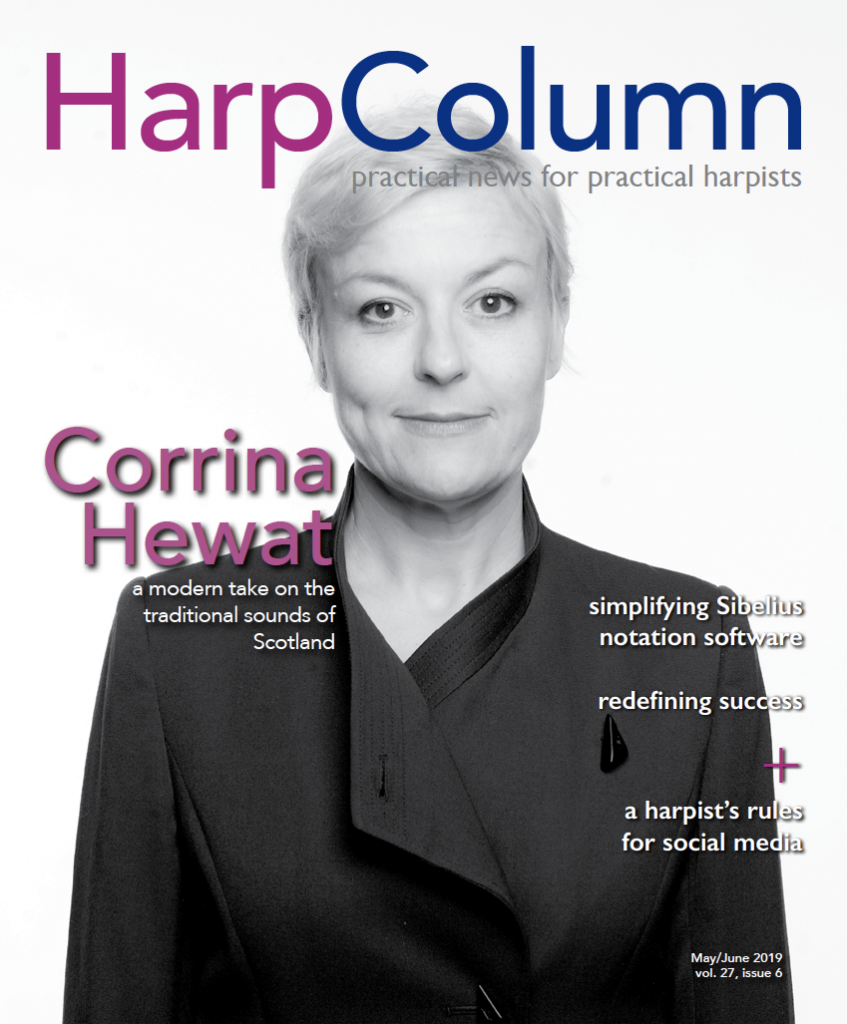
Carl Swanson and his publisher, Carl Fischer Music, have released a new edition of one of the core pieces of our repertoire, Maurice Ravel’s Introduction and Allegro, in a stylish, practical, and detailed edition sure to become the gold standard for this iconic piece.
The days of laboriously copying markings from your teacher’s music are over. Everything a harpist needs to learn or to refresh this wonderful piece can be found in this new publication, which follows Swanson’s editions of the Debussy Danses and the Debussy Trio, all Carl Fischer publications.
The new edition maintains the original Durand layout in terms of well-thought-out page turns and content per page, which is most helpful to those of us who learned the part from the original oversized Durand part. But thankfully, unlike either the original or the reprinted Durand part, this new edition is printed on white 9 -inch by 12-inch quality stock in a clearly readable font. Important as those qualities are, that is the least of what this edition offers.
Here we find all the necessary extra information we harpists need to bring to life a piece of music. Gone are the days of copying out pedals and fingerings. Here the pedals are clearly marked, in an easy-to-read font, placed where they need to happen, with the consistent pattern that many of us like of right foot over left. Fingerings, brackets, and RH/LH indications where they might be helpful are included, and omitted when they would be distracting. No micro-managing here. Pedal charts appear where they are needed or helpful. Enharmonic notes, the ones we actually play, now replace the original notation which is often confusing to the student and the performer.
As Swanson writes in his extensive notes, this edition is based on the printed full score, which Ravel himself would have proofread. While this edition contains the harp part only, Swanson includes a detailed list of corrections needed by the other instrumentalists of the septet, so that all players have the same musical indications.
As almost inevitably happens when composers write for our complicated and, to them, bewildering instrument, there are several places in the score where playing exactly what the composer wrote simply doesn’t work. In his detailed endnotes, Swanson includes various solutions for these measures, printing suggested versions by some of the great performers and teachers of the 20th century: Renié, Jamet, Grandjany, Watkins, and Berghout.
The preface to the edition contains more than enough background on the origins of the composition to become the basis for good program notes. Additionally, there is a discussion of so-called performance considerations, which includes suggestions for optimal seating of the instrumentalists. On the last page is a list of French musical terms and their translations.
Finally, what I find so refreshing is that again and again, Swanson reiterates that while he is presenting this cornerstone of our literature in a practical and playable form, ultimately performers are free to use his suggested fingerings or pedaling or to find their own preferred solutions based on their own hands and technique. This is indeed a publication to add to your library.
Vanderbilt Editions has published a welcome addition to the harp chamber music repertoire with its collection Fauré Songs for Voice and Harp, transcribed by Jacqueline Pollauf.
While harpists revere Gabriel Fauré as the composer of the beloved Impromptu and Châtelaine en sa tour, he is far better known in the wider world for his delicate and evocative art songs. This collection, suitable for the advanced-intermediate level harpist, contains five of these gems, written between 1872 and 1877.
Performed in the order they appear in this publication, these songs would make an appealing recital group. Two of Fauré’s most well-known songs bookend the collection and may be known to harpists in their solo harp arrangements. The accompaniment to “Clair de lune,” the opening song of the collection, is so lovely by itself that Stephanie Curcio has arranged it so that it can be performed as a harp solo without the vocal line. The even more famous “Après un rêve,” the last song in the group, has been arranged by Yolanda Kondonassis as a harp solo combining vocal line and accompaniment. The other songs, chosen by Pollauf, include “Adieu,” a lovely miniature in A-B-A form, and two triple meter lullabies: “Les Berceaux,” and “Sérénade Tuscane.”
Unfortunately, Pollauf does not indicate the vocal range of the selections. As they are all set one step below the way they appear in the standard Fauré collection for high voice, you would assume that they are still in comfortable soprano range. Additionally, there are no translations of the French texts, leaving that important job for the performers.
Pollauf has made few if any changes to the original Fauré piano accompaniments. One of the great features of this edition is the inclusion of the pedal markings all presented in clear fonts. Fauré’s writing can be deceptively chromatic, so this is a great time saver for the harpist. For some reason, however, there is no consistency as to where the pedals are placed on the page. For three songs, the pedals are marked between treble and bass staff, and appear below the staff for the other two. Consistency would have been preferred. Two complete scores are included in the set, one for each performer, which is very helpful.
This collection should bring great enjoyment to both performers and audience, and hopefully will be followed with other publications that add new and accessible pieces to expand our repertoire as performing harpists. •







